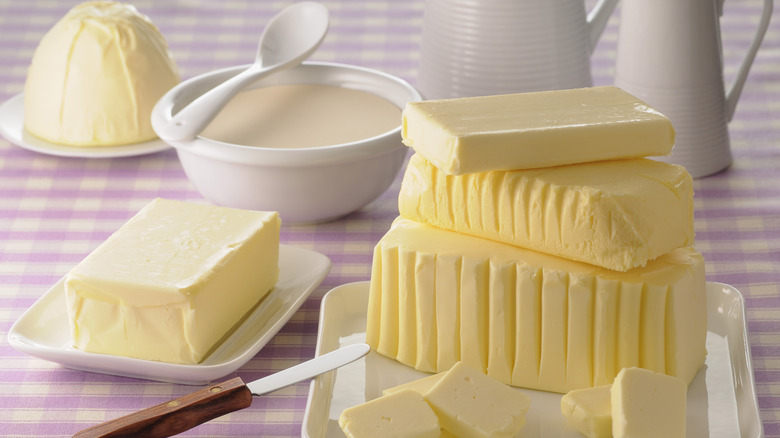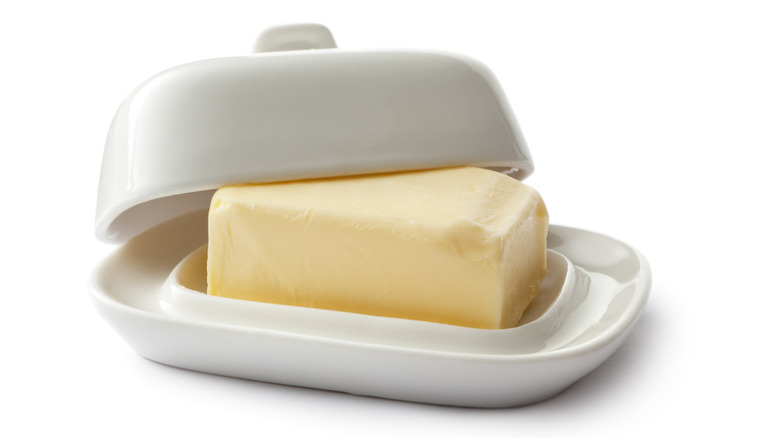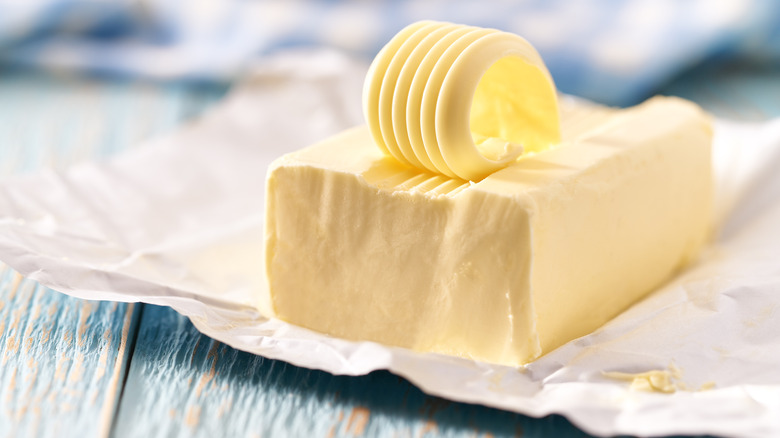For Butter, Room Temperature Is Probably Not What You Think It Is
For many, the idea of keeping butter unrefrigerated might seem a little uncouth operating under the assumption that something made of dairy should be kept cool lest it spoil quickly. However, that is a common misconception! Butter can sit outside of the refrigerator relatively safely because of its low water content, which makes it more resistant than other types of dairy to bacterial growth. Though the decision to keep butter above refrigerator temperatures is motivated by the convenience of spreading it easily, "room temperature" for butter isn't the same as air.
Room temperature is generally thought to be somewhere around 72 degrees Fahrenheit, but that isn't necessarily where you want your butter to be. No matter which butter brand you may have purchased, when it comes to what's best, an internal temperature that attains the preferred softness is what you should be angling for. There are a couple of tried and true tactics to use to see if your butter has gotten to the optimum warmth, so let's take a look!
Soft butter is oft better
Ideally, butter that has been left out of the refrigerator is well on its journey toward pillowy softness. When it has hit the perfect texture, your butter should have an internal temperature of around 65 to 67 degrees Fahrenheit — well below what we consider room temperature to be. To tell if it's gotten to that comfortable state, you can take one of two avenues. The first, and simplest, is to gently press the butter with your finger to gauge the viscosity. If the finger press makes an indentation that stays, you should be right where you want it. The touch should feel not too greasy, as you do want some firmness to hold, but otherwise, this light, soft butter is ready for use in your baking, or to be set out for spreading on whatever you or your guests might desire.
The other, more scientific approach is using a thermometer to tell exactly what temperature your butter is on the inside. Same as before, you should be looking for the mid to upper 60s, which should be easy to tell with the proper tool at your disposal. Just place a standard thermometer into the center of the block to see, and hope the readout is what you're aiming for. After that, it's ready to serve to any eager guests awaiting something to put on that baguette you just sliced!
Getting the most out of your warmed butter
Even though it's able to withstand time in the open air, butter is by no means immortal or magic. If leaving your butter out is something you'd like to put into practice, be sure to follow certain safety precautions to ensure nothing goes awry. First of all, be sure to keep it out for a maximum of 48 hours, as the USDA recommends, to maintain freshness. Though butter has low moisture and high fat, which helps keep bacteria at bay, it's best to return it to refrigeration after a day or two to promote longevity. Speaking of longevity, if you're using salted butter you'll get even more protection from any potential germs, as the added salt works as a natural preservative and deterrent. Furthermore, keeping the room temperature butter in a proper container, away from the open air, will not only keep the butter fresher but will create its own temperate environment away from any surprises the outside could bring (like say, a pet licking or stepping on it!)
Butter is an essential part of the culinary experience, so be sure to take the steps necessary to get the most out of every spread! Keeping a container of it at the ready will not only provide you with an adequately soft texture but will ensure a rock hard pat of it doesn't crumble your next slide of toasted brioche. Make keeping your butter warm the norm!


